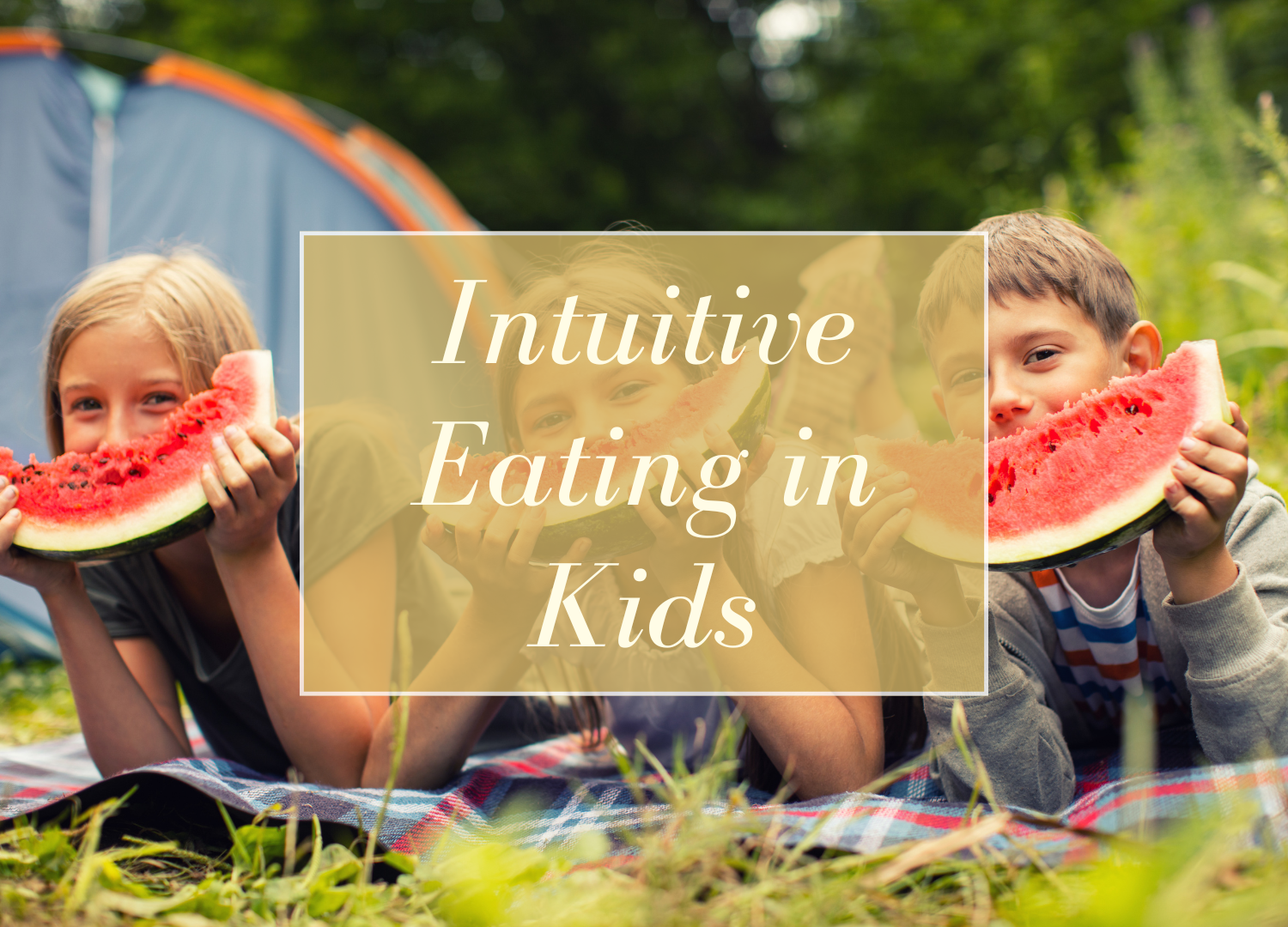Intuitive Eating in Kids
Did you know that we are all born Intuitive Eaters? In today’s post, Jennie is sharing ways to support your kids around food and how to encourage them to eat intuitively. Take it away, Jennie!
Intuitive Eating in Kids
Parenting doesn’t come without its challenges, and raising kids to be healthy eaters is of course something parents strive for. A lot of the time, unfortunately, teaching kids to eat “healthy” can easily get intermixed with messages from diet culture. This well-meaning approach may not only make kids start to distrust their internal signals but can also hurt their ability to be an Intuitive Eater as an adult. This especially can become a problem as foods are labeled “good” vs “bad”, kids are forced to finish a certain “healthy” food to earn dessert, or when they get rewarded for clean plates. So how exactly do we raise our kids to be intuitive eaters, while encouraging eating habits that promote good health? Let’s unpack that today!
What is Intuitive Eating?
Intuitive eating is something innate that we are all born with. It’s the ability to trust our body’s hunger and satiety signals to eat the appropriate amount of food our body needs at that given time. It allows for the inclusion of “fun foods” in our everyday eating without the feelings of guilt or shame. It contradicts diet culture by allowing us to have peace with all foods and honor our bodies by accepting the genetic blueprint we were given rather than being overly critical of body shape and size.
Self-regulation is the backbone of intuitive eating, and humans are born with the ability to self-regulate their food intake to stay in balance. This ability is managed by an intricate system of hormones, nerves, and neurochemicals. When parents exert control, pressure, and restriction regarding food intake among their children, this weakens the child’s ability to trust the body signals they were born with (1).
So how do I raise my child to be an intuitive eater?
Provide unconditional love and support for your child’s body (1)
Create an environment at home that respects all body shapes and sizes. In a study about the way adolescents behave around food when they perceive their weight as healthy (regardless of BMI or what others perceived their weight to be), they were less likely to engage in restrictive dieting behaviors or use methods like purging or laxatives to control weight (1). They were able to have a healthier relationship overall with their bodies and with food. When kids don’t have internal weight stigma, they are healthier overall DESPITE body weight.
How exactly can you provide unconditional love and support for your child’s body?
Reduce body shame: Kids can feel this by even the smallest comments about the size of their body or the way that they eat. Talk with your kids openly about body size diversity, create a safe space to bring up any size bullying your child might encounter while at school or with peers, and openly answer questions your kids may have as they grow into their new bodies during puberty. Diet culture has normalized body shaming rather than body appreciation. Normalizing all body types will help your child believe that they are lovable no matter what their body size is (consider body neutrality). Instead of emphasizing physical traits, focus on praising them for internal traits or successes they have in school, activities, etc. This will help them grow to learn that accomplishments and who they are as a person are unrelated to physical appearance.
Embrace their needs: Food is often used as a method to soothe a child who is upset. Instead of using foods, help kids sit in their feelings and cope with their emotions in other ways.
Accept their food desires: Cravings for certain foods are normal. There is a lot of talk right now about sugar “addiction” and that sugar is toxic for our children. Sugar (glucose) is the primary source of fuel for our brain and muscles. Of course, children are going to crave this! It tastes good, and it’s a quick fuel source for their brains and bodies which are growing and moving constantly. Sugar restriction fuels sugar cravings. Allowing children to have sugary foods in addition to meals balanced with other nutrients is part of letting them eat foods they enjoy without feeling the pressures of the food police. Instead of glamourizing dessert by making them earn it at the end of a meal, serve it alongside the main course. Every time I do this with my own kids, they are much more likely to eat the other foods on their plate than if they are asked to finish their meal before they get the dessert. And remember, if kids are craving something sweet, offering fruits that have naturally occurring sugars in addition to health-promoting nutrients like fiber and several vitamins and minerals is a great option.
Provide a flexible and reliable feeding routine (1)
Structure with kids is important, but allowing some flexibility in their food choices and eating routine is crucial to helping them tune into their inner intuitive eating voice. Diet culture is full of food rules and rigidity, and because of this embracing eating flexibility with kids may go against everything that has been ingrained in us for years. Modeling this around children is equally important. Do your kids see you skipping out on a fun dessert in the name of “health” or saving calories? Do you cut out certain foods at mealtimes that the rest of the family may be eating? Do they see you skip meals, or replace food with beverages? Modeling intuitive eating for our kids is so conducive to cutting out that societal message that thin bodies are ideal, and will better equip them to continually trust their bodies and what they need.
A feeding routine is important for kids so that they know food will always be available for them. Without this, feelings of restriction can lead to cravings and disrupt hunger cues. This can lead to the likelihood of a child sneaking food, and possibly binging when food is available. Offer regular meals with snacks at reliable times. Flexibility in this routine allows for fun snacks outside the ordinary, includes foods your child likes (especially important with picky eaters), and offer a variety of foods for each meal. It’s the child’s job to decide whether or not they want to eat it, and how much of it they want to eat. Things like the “clean plate club”, rewarding the consumption of certain foods with a dessert (for example offering candy if the child eats their vegetables), and shaming a child if they refuse to eat everything on their plate is not helpful for raising intuitive eaters.
Finally, letting go of diet culture norms in your home is so important. This can come in the form of pressuring kids to eat “healthy” foods and restricting “unhealthy” foods. This backfires for a couple of reasons. First of all, labeling foods as healthy vs unhealthy can completely disrupt their relationship with food. Most kids who are labeled picky eaters become open to a larger variety of foods later in life. As a parent, your job is to offer a variety of foods often. Kids who are exposed to a variety of foods at meals and snacks including colorful fruits and veggies, varying types of protein and grains, along with fun foods without restriction, are more likely to stay intuitive eaters into adulthood. They are also more likely to have a positive relationship with food and their bodies. Secondly, restricting foods only increases their preference for the food being restricted (see Restrict/binge Cycle). When they can eat the food being restricted, they will have a heightened response to the taste and pleasure of that food, driving the urge to want more, and may eventually feel out of control with those foods(1).
Raising an intuitive eater doesn’t have to look perfect, and that’s the beauty of it! No rules, no restrictions, no perfect eating. Just allowing your child to stay in tune with their individual needs, ditching diet culture rules, and embracing positive embodiment.
Resources Used:
[1] Brooks, B & Severson, A. (2022). How to Raise an Intuitive Eater. Raising the Next Generation with Food and Body Confidence.


